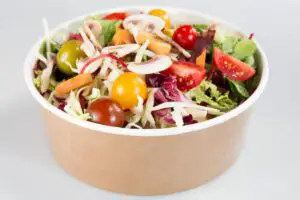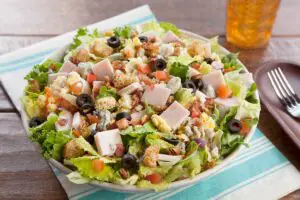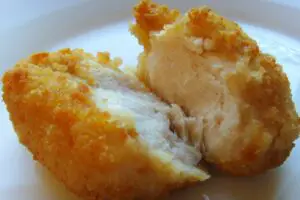*This post may contain affiliate links. As an Amazon Associate we earn from qualifying purchases.
Taco Bell serves their guest tacos, burritos, quesadillas, and American-Mexican fast food. What if Taco Bell was on the menu for your lunch today, but you wound up not eating everything? You have leftovers and instead of just throwing them away you want to save them for lunch on another day.
So, not wanting to be wasteful, you refrigerate the remaining tacos, preserving them for a meal some other time. When it comes time to reheat your Taco Bell you wonder which way to do it so they will be crispy?
Can you put Taco Bell in the air fryer?
You can put your leftover Taco Bell in the air dryer to reheat it. You will want to take it out of its original wrapper before air frying it though.
If you like Taco Bell you may feel bad about throwing away what you haven’t eaten and that’s ok. You can save the tacos to eat later by refrigerating or freezing them.
When you want to eat your Taco Bell tacos, you can use several things to heat them up.
First, it is said that the best way to reheat the tacos is to separate the ingredients and heat them accordingly. Some items don’t need to be heated like lettuce, tomatoes, etc. Then you can go about reheating the shell in the oven.
The oven is the best way to heat up your leftover Taco Bell. It will result in the crispiest tacos. You can also use a stove to reheat the tacos.
Using a microwave will make the tacos soggy but if you are in a hurry, this is the fastest way to reheat them.
Then there’s the air fryer. This is a great way to reheat the taco and is pretty fast, too.
When you heat your leftover Taco Bell in the air fryer you will be able to enjoy crunchy tacos tasting just as crispy and crunchy as when you bought them.
How Do You Air Fry Taco Bell?
Leftover Taco Bell can be nice to save for meals later on. Now that we know they can be reheated, how do you use the air fryer to reheat your Taco Bell food?
You can air fry your food from Taco Bell by placing the food in the basket of the air fryer and heating it up this way. Ideally you will want to remove things like lettuce or tomato before putting it in the air fryer.
If you have frozen some Taco Bell food and are reheating it using an air fryer, heat the air fryer to 400 degrees Fahrenheit. Then place the tacos in the basket and place the basket into the air fryer.
Decrease the temperature to 350 degrees Fahrenheit and reheat the taco for about 3 minutes. Take the basket out and check on your tacos. If they need more time, put the basket back into the air fryer and heat for another minute or two.
Watch the tacos to make sure they do not burn. And there you go! You can eat your reheated tacos and they will be crispy and good even after being stored in the freezer for a while.
Using an air fryer to reheat your Taco Bell is the most effective way of doing it. The taco will come out crispy instead of soggy and will taste good.
Taco Bell’s Crunchwrap is reheated the same way. Just put it in the air fryer for a few minutes and flip halfway through. Reheating Taco Bell’s burrito is simple as well.
Preheat the airfryer to 325 degrees Fahrenheit and spray it with some oil. Air fry the burrito for 14 to 16 minutes or until the shell starts to turn golden brown and is toasted evenly. Then you are all set to eat your yummy Taco Bell.
Freezing and reheating food can alter its taste and texture but is a great way to save it for future use.
Is Taco Bell Healthy?
Usually Taco Bell will only last in the fridge for a couple days and in the freezer for a few months. If you enjoy Taco Bell you may like to stock up and have some on hand when you get a craving for their tacos. But is Taco Bell healthy?
Taco Bell isn’t really all that healthy when compared to making food at home. However, Taco Bell has been reconstructing its menu and is now one of the country’s healthiest fast-food chains.
Now, this may sound unusual because what fast-food is actually healthy? But by adding in healthier choices on its menu, customers can choose if they would rather order something not so unhealthy.
An article from Insider states that, “Taco Bell now offers so much more than the traditional menu we’re used to. There is now a low-calorie “Fresco” menu, a high-protein “Cantina” menu, and a vegetarian menu certified by the American Vegetarian Association. The vegetarian menu even comes with vegan-friendly selections, all of which can be found on the Taco Bell app.”
So, even though Taco Bell still features unhealthy items on their menu, those who eat there can have a healthier menu to choose from. Taco Bell doesn’t want to promote themselves as a healthy restaurant however, just offer their customers better food choices.
The article from Insider continues to say that, “With a touch of a button, your order can be customized to fit your dietary needs, which leaves endless options for customization. And by adding these extra, health-conscious menus, Taco Bell gets to keep the traditional fast food menu, while allowing for another avenue to drive new business.”
While it may be surprising, Taco Bell isn’t just good, it is one of the healthiest fast food restaurants offering their customers a menu of healthier options. They’ve kept this low-key but anyone who wants to eat healthier can.
Final Thoughts
Have a lot of leftover Taco Bell?It’s ok to save Taco Bell as this just means you don’t want to be wasteful and throw it all away. I mean, you spent good money on that food and it tastes really good.
If you do have leftover Taco Bell that you don’t want to waste, freeze it for later. Although freezing food preserves it, it can cause it to lose its flavor and texture over time so be sure to eat your leftover Taco Bell as soon as you can.
When you do want to eat them, you can reheat them several different ways. One of the best ways to reheat Taco Bell food is by using the air fryer to get the tacos crispy and crunchy.
Like Taco Bell would say, “Live Mas”!









